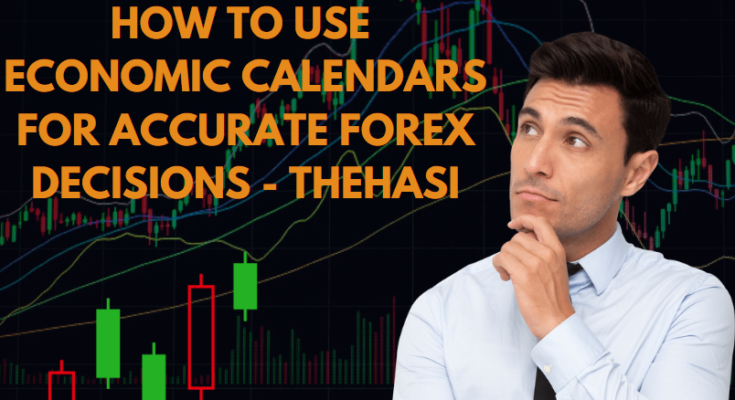In the fast-paced world of Forex trading, timing is everything. Currency prices can fluctuate rapidly based on economic data, making it essential for traders to stay ahead of key events. This is where the economic calendar comes into play. Understanding how to use an economic calendar can help you make better trading decisions and take advantage of market movements. In this article, we’ll simplify how to use the economic calendar to make more accurate Forex trading decisions.
1. What is an Economic Calendar?
An economic calendar is a tool that lists all scheduled economic events, reports, and news releases that can affect the Forex market. These events typically include things like:
- Interest rate decisions
- Employment data
- Gross Domestic Product (GDP) reports
- Inflation updates
The data provided by these reports reveals how well a country’s economy is doing, which in turn impacts its currency. Traders use the calendar to track these events and make informed decisions based on the likely market impact.
2. Why Should Forex Traders Use an Economic Calendar?
For Forex traders, the economic calendar is one of the most valuable tools. Here’s why:
- Predict Price Movements: Major economic events often lead to sharp price movements in currency pairs. By knowing when these events are happening, you can better predict price trends and adjust your trades accordingly.
- Minimize Risk: Many traders find that certain economic events lead to increased market volatility. By using the calendar, you can plan your trades around these times and reduce your exposure to unexpected market fluctuations.
- Improve Strategy: By staying on top of economic data, you can tweak your trading strategy to better align with the potential impact of each event.
3. How to Read an Economic Calendar
Now that you understand what an economic calendar is and why it’s important, let’s look at how to use it. The calendar is fairly easy to understand once you know what to look for:
A. Event Name
Each entry on the calendar refers to a specific economic report or event. Some common events include:
- Non-Farm Payrolls (NFP): Measures employment growth in the U.S.
- Central Bank Rate Decisions: Announcements from institutions like the Federal Reserve or European Central Bank (ECB).
- GDP Reports: Show the overall economic performance of a country.
- Consumer Price Index (CPI): Tracks inflation and the cost of living.
B. Date and Time
Each event has a scheduled date and time. Most economic calendars will list the time in GMT/UTC, so make sure to adjust for your local time zone.
C. Impact Level
Each event is typically rated by its potential impact on the Forex market:
- Low Impact (Green): Events that won’t likely cause much market movement.
- Medium Impact (Yellow): Events that could cause some fluctuations but are unlikely to make major waves.
- High Impact (Red): Major events that could trigger significant price movements.
As a Forex trader, your focus should be on high-impact events, as these provide the best opportunities for profit.
D. Forecast vs. Actual
Economic reports include both a forecast (what analysts predict) and an actual result (the real data). A large deviation between the forecast and the actual number can lead to sharp movements in the currency market. For example, if the forecast for Non-Farm Payrolls is 100,000, but the actual result is 200,000, the U.S. Dollar (USD) may strengthen dramatically.
4. Key Economic Events Every Forex Trader Should Watch
Certain economic events can have a profound effect on the Forex market, especially when released unexpectedly or significantly deviating from forecasts. Let’s go over the major events you should monitor:
A. Interest Rate Decisions
Interest rate decisions made by central banks like the Federal Reserve (Fed) or European Central Bank (ECB) can lead to dramatic changes in a currency’s value. When a central bank raises interest rates, it typically strengthens the currency because higher interest rates make a currency more attractive to investors.
- Example: If the Federal Reserve raises interest rates, the U.S. Dollar (USD) tends to appreciate against other currencies like the Euro (EUR) or British Pound (GBP).
B. Non-Farm Payrolls (NFP)
The Non-Farm Payrolls report is one of the most eagerly anticipated economic data releases in the U.S. It shows how many jobs were added to the economy (excluding farm workers and government employees). A strong NFP report usually suggests that the economy is doing well and that the U.S. Dollar may strengthen.
- Example: A strong NFP report can lead to a USD rally, while a weaker-than-expected report can result in a weaker USD.
C. Gross Domestic Product (GDP)
GDP measures a country’s total economic output and growth. If a country’s GDP is growing, it indicates a strong economy, which can lead to an appreciation of its currency.
- Example: A strong Eurozone GDP report could lead to a stronger Euro (EUR), as it shows the Eurozone’s economic strength.
D. Consumer Price Index (CPI)
The CPI tracks inflation by measuring the price changes of a basket of goods and services. Higher inflation often leads to higher interest rates, which can boost a currency’s value.
- Example: A higher-than-expected CPI in the U.S. could suggest that the Federal Reserve may raise interest rates, which may strengthen the USD.
5. How to Use Economic Calendars in Your Trading Strategy
Now that you understand how to read the calendar and which events to focus on, let’s dive into how you can use the economic calendar in your trading strategy.
A. Plan Your Trades Ahead of Time
Before the economic event occurs, analyze the forecasted data and compare it to previous reports. If there’s a large deviation expected, prepare for possible volatility. For example, if interest rates are expected to rise sharply, you may want to consider buying the currency that benefits from the rate hike.
B. Anticipate Market Sentiment
Market sentiment can heavily influence the impact of economic events. Sometimes, the market has already priced in the expected results, so when the actual data is released, there may not be as much of a market move as you anticipated.
C. Post-Event Trading
Many traders choose to wait until after the economic event has been released and the initial volatility has subsided. This way, you can avoid sudden market swings and look for more stable entry points.
D. Combine with Technical Analysis
While the economic calendar provides fundamental data, combining this information with technical analysis (like chart patterns, moving averages, and trend lines) can give you a clearer picture of what to expect in the market.
6. Risk Management During Economic Events
High-impact economic events can bring about extreme volatility, which is both an opportunity and a risk. Here’s how to manage that risk:
A. Use Stop-Loss Orders
Always use stop-loss orders to protect yourself from drastic price movements. Setting a stop-loss level before key events ensures you won’t lose more than you’re willing to risk.
B. Avoid Overleveraging
Leveraging your position can be tempting, but it’s risky, especially during volatile periods. Consider reducing your leverage when trading around major economic releases to protect your capital.
C. Trade Smaller Sizes
During periods of high volatility, consider trading smaller positions. This way, you can still participate in the market without risking too much on one trade.
7. Common Mistakes to Avoid
Here are a few common mistakes that Forex traders make when using economic calendars:
- Ignoring Market Sentiment: Always check how the market is reacting before jumping into a trade. Sometimes, the market already prices in the expected results.
- Trading on Emotion: Don’t let fear or greed dictate your trades. Always trade with a clear plan.
- Chasing the News: Don’t blindly follow the market’s first reaction to the news. It’s important to wait for some market stabilization before making your move.



